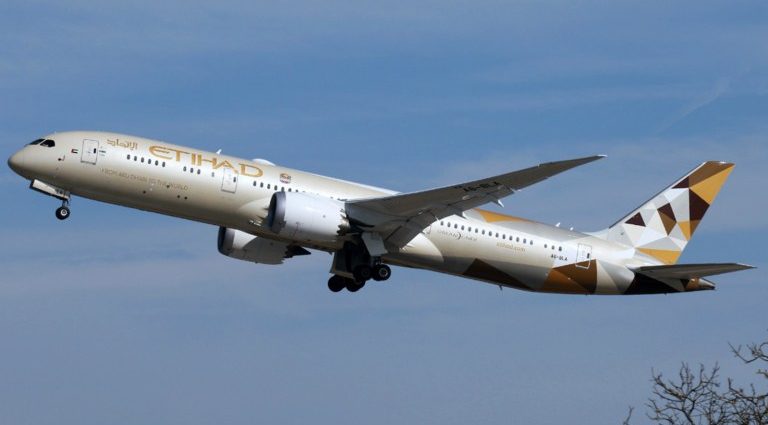
An airliner over Dubai’s coast, a single-engine helicopter, and a Japan-Abu Dhabi flight: Sustainable aviation fuel (SAF) has proved capable of powering air travel. But can supply rise and cost fall fast enough to make SAF a major part of the aviation industry’s journey to net-zero emissions?
While aviation is responsible for about 2% of global greenhouse gas emissions, a small but fast-growing amount, it could be two to four times as high by 2050. Its impact on global warming is higher, about 3.5%, because of the formation of high-altitude condensation trails – or “contrails” – which trap heat.
Environmentalists have proposed avoiding air travel in favor of high-speed rail. This has a place, but with demand for flights likely to rise, low-carbon options are needed.
The Middle East and North Africa (MENA) region must take curbs on aviation emissions particularly seriously. It has become a global flight hub, with several regional countries – notably the United Arab Emirates but also Qatar, Saudi Arabia and Turkey – betting big on economic diversity through mega-airports, super-connector airlines and spin-offs, from tourism to cargo. That won’t work if future air travel is restricted.
The International Air Transport Association (IATA) resolved in October 2021 that members would reach net-zero carbon emissions by 2050. Its strategy includes improved efficiency, new hydrogen- and battery-powered planes, and offsets, such as funding tree planting or the direct removal of atmospheric carbon dioxide.
Low-carbon aviation fuel (LCAF) carefully selects the origin and refining of crude oil to reduce life-cycle emissions by at least 10%.
But the heavy lifting – 65% of total reductions – hinges on SAF. Planes today overwhelmingly run on kerosene made from petroleum. By contrast, SAF is derived from non-fossil sources, either leftovers such as cooking fat, other biomass or waste materials, or custom-grown feedstocks including sugar, alcohols and palm oil.
Carbon taken up by these biological materials as they grow is released when the fuel is burned, making it carbon-neutral in principle. With some development, these will yield an 80% reduction in life-cycle emissions. Research also suggests that SAF reduces contrails.
SAF is a drop-in fuel – meaning it can be used in conventional jet engines without modification, blended with kerosene or on its own.
Last October, Etihad flew from Tokyo’s Narita International Airport to Abu Dhabi using a 40% SAF blend. In January this year, Emirates Airlines made the first demonstration flight in the MENA region with one of two Boeing 777 engines running entirely on SAF. In February, the US aerospace company Bell Textron made the first single-engine helicopter flight using only SAF.
Worldwide production of SAF tripled in 2022, but the total estimate of between 300 million and 450 million liters is far short of the 2050 annual target of 449 billion liters. That is equivalent to nearly 8 million barrels per day of oil and almost a thousand times current output.
SAF is also expensive. When oil prices spiked last year, it still cost about twice as much as conventional jet fuel, and it is often said to be up to four times as costly. Fuel costs depend on oil prices, but may be around a third of an airline’s total costs – implying running solely on SAF would hugely inflate ticket prices.
Costs will come down as the industry scales up, SAF becomes more widely available, and conversion technologies improve. But overall usable volume is also limited by feedstock. Suitable wastes are limited, and are sought by other industries looking to decarbonize, such as shipping, ground transport and bioplastics.
Growing dedicated crops can also damage the environment through fertilizer use and water consumption while competing with food production and the preservation of forests and other biodiverse areas.
Global biofuels output in 2021, mostly for road use, was just 1.7 million barrels per day – a number that would have to quadruple to meet 2050’s SAF needs.
Given the challenge to a major part of its economic model, it’s crucial the MENA region finds solutions for climate-neutral aviation. Technology is part of the solution. In the short term, it will help to scale up SAF use and provide reliable logistical solutions.
As an emerging hub for clean hydrogen production, it would be of great interest in MENA to commercialize hydrogen-based routes to SAF. Developing innovative SAF production, LCAF and direct air capture of carbon dioxide fits well with its national oil companies’ skill sets.
In January, Abu Dhabi’s Masdar, TotalEnergies, Siemens Energy and Marubeni teamed up to work on conversion of methanol to jet fuel. Other more advanced pathways to synthetic jet fuels, beginning with sustainably produced hydrogen or innovative biological pathways such as algae, could sidestep the problems of land use.
Hydrogen-based SAF has been technically certified, but the costs of hydrogen production and conversion must fall substantially.
Just as important is to create business models and incentives to reward environmentally responsible aviation. Many companies have internal net-zero carbon goals, so they can be offered SAF-based flights or appropriate offsets such as reliable bio-sequestration or carbon capture, at a suitable premium.
Private jets, often with just a few wealthy passengers, could be required to use SAF or other low-carbon options – creating an early-adopter luxury market.
The Middle East can wait for punitive policies from Europe, or it can ensure the future of its national carriers as frequent yet responsible fliers.
This article was provided by Syndication Bureau, which holds copyright. Follow Robin Mills on Twitter @robinenergy.

